Impact Analysis of High-Altitude Electromagnetic Pulse Coupling Effects on Power Grid Protection Relays
Abstract
1. Introduction
- The component of primary interest for this work was the early-time (E1) element. A high-altitude electromagnetic pulse event is capable of inflicting catastrophic damage on electrical infrastructure across an expansive area [9]. In scenarios involving high-altitude nuclear explosions, terrestrial electrical power systems are particularly susceptible to HEMP effects. The most notable direct encounter with an E1 HEMP occurred during a high-altitude nuclear test by the USA in 1962, which was conducted 400 km above the mid-Pacific Ocean. The repercussions of this test were felt over 1445 km away in Hawaii, with more than 300 reports of equipment damage, affecting streetlights, burglar alarms, and a microwave link [10]. This incident underscored the substantial threat posed by EMPs to power system infrastructure.
- The E2 phase of a HEMP exhibits many similarities to lightning, particularly regarding its timing [11]. E2 couples to electrical equipment via airborne mechanisms, more akin to the E1 pulse than to lightning. Nonetheless, the effects of an E2 HEMP closely resemble those of lightning strikes [12]. Despite this, E2 is generally not viewed as a significant threat, primarily due to its relatively low amplitude of approximately 0.1 kV/m. Various devices, such as lightning surge arresters, are effective in protecting against both lightning and E2 pulses. However, the predominant concern is that an E2 pulse often follows the more destructive E1 pulse. If lightning surge arresters or other protective measures are compromised by an E1 pulse, the subsequent E2 can cause significant damage to components.
- Similarly, the E3 HEMP phase and geomagnetic disturbances share characteristics that render them comparable in terms of their impacts and the damages they cause [13,14]. These disturbances couple efficiently with long transmission lines, potentially generating ground-induced currents in the range of hundreds to thousands of amperes. For instance, in 1989, a geomagnetic storm damaged a Hydro Quebec transformer and capacitor, leading to a shutdown of 21 gigawatts of power supply within one minute [15]. This event plunged the entire province of Quebec, Canada, into darkness for over nine hours. E3-induced currents are low frequency, and thus, may saturate magnetic equipment, such as transformers.
2. Equipment Illustration
2.1. Protection Relays
- Current transformer (CT) and voltage transformer (VT): these components reduce the current or voltage of a device to a measurable level.
- Protection relay: receives measurement signals from the secondary sides of CTs and VTs to determine whether the protected line or equipment is under stress.
- Circuit breaker: operates based on the commands from the protection relay, opening when a fault is detected and closing after the fault is cleared.
- Communication module: facilitates the transmission of information and measurements from one relay to another receiving relay or substation.
2.1.1. Description of Protection Relays
2.1.2. Determination of Measurement Ports
2.2. Impedance Measurement Instruments
3. Impedance Measurement and De-Embedding Process
3.1. Calibration, Configuration, and Measurement
3.2. De-Embedding Process for the Sensor
3.3. Measurement Results and Modeling of Equipment
4. Simulation Methodology
4.1. Pulse Current Injection Method
4.2. FEKO Plane Wave Simulation
5. Study Results
5.1. Impedance Results
5.2. PCI Method Results
5.3. FEKO Simulation Results
5.4. Evaluation
6. Conclusions
Author Contributions
Funding
Data Availability Statement
Acknowledgments
Conflicts of Interest
Appendix A
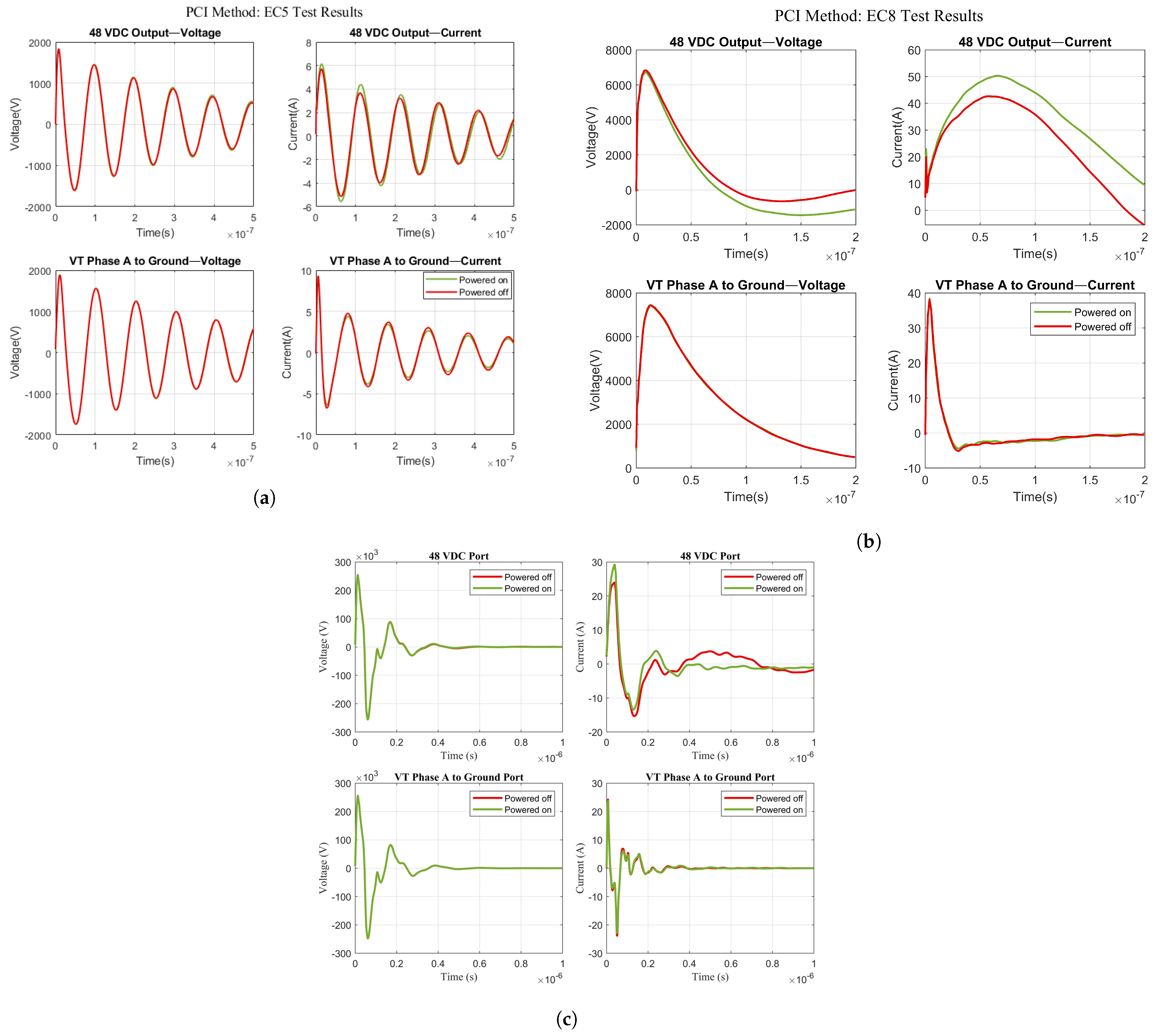
References
- Foster, J.S.; Gjelde, E.; Graham, W.R.; Hermann, R.J.; Kluepfel, H.M.; Lawson, R.L.; Soper, G.K.; Wood, L.L.; Woodard, J.B. Report of the Commission to Assess the Threat to the United States from Electromagnetic Pulse (EMP) Attack, Critical National Infrastructures; U.S. Government Printing Office: Washington, DC, USA, 2008. [Google Scholar]
- Li, P.; Wu, Q. Dynamic Numerical Analysis of Interactions between High-Altitude Electromagnetic Pulse and Power Grid. IEEE Trans. Electromagn. Compat. 2023, 65, 1801–1810. [Google Scholar] [CrossRef]
- Kopp, C. The Electromagnetic Bomb: A Weapon of Electrical Mass Destruction; Monash University: Clayton, VIC, Australia, 1996. [Google Scholar]
- Wang, D.; Li, Y.; Dehghanian, P.; Wang, S. Power Grid Resilience to Electromagnetic Pulse (EMP) Disturbances: A Literature Review. In Proceedings of the 2019 North American Power Symposium (NAPS), Wichita, KS, USA, 13–15 October 2019; pp. 1–6. [Google Scholar] [CrossRef]
- Pukkalla, S.K.; Subbarao, B. Study on Modeling & Simulation Analysis of Electromagnetic Pulse (EMP) Coupling to Cables. In Proceedings of the 2018 15th International Conference on ElectroMagnetic Interference & Compatibility (INCEMIC), Bengaluru, India, 13–16 November 2018; pp. 1–4. [Google Scholar]
- Foster, R.A.; Frickey, S.J. Strategies, Protections and Mitigations for Electric Grid from Electromagnetic Pulse Effects; Technical Report; Idaho National Lab. (INL): Idaho Falls, ID, USA, 2016. [Google Scholar]
- Qiu, W.; Zhang, L.; Yin, H.; Markel, L.C.; Liao, D.; McConnell, B.W.; Liu, Y. Modeling, testing, and mitigation of electromagnetic pulse on PV systems. Sol. Energy 2023, 264, 112010. [Google Scholar] [CrossRef]
- Liao, D.; Liu, Y.; Markel, L.C.; McConnell, B.W.; Mignardot, D.P.; Poole, B.R.; Wang, L. Estimation of High-Altitude Electromagnetic Pulse Coupling onto Power Generation Facility Equipment. In Proceedings of the 2023 IEEE International Symposium on Antennas and Propagation and USNC-URSI Radio Science Meeting (USNC-URSI), Portland, OR, USA, 23–28 July 2023; pp. 265–266. [Google Scholar]
- Savage, E.; Gilbert, J.; Radasky, W. The Early-Time (E1) High-Altitude Electromagnetic Pulse (HEMP) and Its Impact on the US Power Grid; Report Meta; Metatech Corporation: Goleta, CA, USA, 2010. [Google Scholar]
- Vittitoe, C.N. Did high-altitude EMP cause the Hawaiian streetlight incident. In System Design and Assessment Notes; Sandia National Lab.: Albuquerque, NM, USA, 1989. [Google Scholar]
- Rowland, H.; Fernsler, R.; Huba, J.; Bernhardt, P. Lightning driven EMP in the upper atmosphere. Geophys. Res. Lett. 1995, 22, 361–364. [Google Scholar] [CrossRef]
- Rashid, R.; Gilani, S.A.A. Electromagnetic Pulse (EMP): A Study of General Trends, Simulation Analysis of E1 HEMP Coupling and Protection Strategies. In Proceedings of the 2021 International Conference on Cyber Warfare and Security (ICCWS), Islamabad, Pakistan, 23–24 November 2021; pp. 106–111. [Google Scholar] [CrossRef]
- Adhikari, S.; Mueller, D.; Walling, R.; O’Laughlin, A.J. A comprehensive study of geomagnetic disturbance (GMD) system impact. In Proceedings of the 2017 IEEE Power & Energy Society General Meeting, Chicago, IL, USA, 16–20 July 2017; pp. 1–5. [Google Scholar] [CrossRef]
- Mate, A.; Barnes, A.K.; Bent, R.W.; Cotilla-Sanchez, E. Analyzing and Mitigating the Impacts of GMD and EMP Events on the Electrical Grid with PowerModelsGMD.jl. arXiv 2021, arXiv:2101.05042. [Google Scholar]
- Kappernman, J.; Albertson, V. Bracing for the geomagnetic storms. IEEE Spectr. 1990, 27, 27–33. [Google Scholar] [CrossRef]
- Liao, D.; Li, Z.; Liu, Y.; Markel, L.; Mcconnell, B.; Poole, B.R.; Wang, L. Estimation of High-Altitude Electromagnetic Pulse Signal Leakage into Power Generation Facilities: Simulations and Measurements; Technical Report; Oak Ridge National Lab. (ORNL): Oak Ridge, TN, USA, 2022. [Google Scholar]
- Mignardot, D.; Liao, D.; Markel, L.; Liu, Y. Electromagnetic Penetration of Structures with Applications in Vulnerability Assessment; Technical Report; Oak Ridge National Laboratory (ORNL): Oak Ridge, TN, USA, 2023. [Google Scholar]
- Xie, H.; Du, T.; Zhang, M.; Li, Y.; Qiao, H.; Yang, J.; Shi, Y.; Wang, J. Theoretical and Experimental Study of Effective Coupling Length for Transmission Lines Illuminated by HEMP. IEEE Trans. Electromagn. Compat. 2015, 57, 1529–1538. [Google Scholar] [CrossRef]
- Ferreira, V.; Zanghi, R.; Fortes, M.; Sotelo, G.; Silva, R.d.B.M.; Souza, J.; Guimarães, C.; Gomes, S., Jr. A survey on intelligent system application to fault diagnosis in electric power system transmission lines. Electr. Power Syst. Res. 2016, 136, 135–153. [Google Scholar] [CrossRef]
- Horibe, M. Performance comparisons between impedance analyzers and vector network analyzers for impedance measurement below 100 MHz frequency. In Proceedings of the 2017 89th ARFTG Microwave Measurement Conference (ARFTG), Honolulu, HI, USA, 9 June 2017; pp. 1–4. [Google Scholar]
- Bridges, J.; Wells, W.; Peach, L.; Emberson, W.; Townsend, L.; IIT Research Institute. EMP preferred test procedures. Revision. NASA STI/Recon Tech. Rep. N 1977, 77, 31383. [Google Scholar]
- Cui, Z.; Grassi, F.; Pignari, S.A.; Wei, B. Pulsed current injection setup and procedure to reproduce intense transient electromagnetic disturbances. IEEE Trans. Electromagn. Compat. 2018, 60, 2065–2068. [Google Scholar] [CrossRef]
- IEC:61000-4-25; Electromagnetic Compatibility (EMC)—Part 4-25: Testing and Measurement Techniques—HEMP Immunity Test Methods for Equipment and Systems. International Electrotechnical Commission: Geneva, Switzerland, 2021.
- Liao, D.; Liu, Y.; Markel, L.; Mcconnell, B.; Mignardot, D.; Poole, B.R.; Wang, L. A Systematic Approach for Estimating High-Altitude Electromagnetic Pulse Coupling onto Power Generation Facility Equipment; Technical Report; Oak Ridge National Laboratory (ORNL): Oak Ridge, TN, USA, 2023. [Google Scholar]
- Benmouyal, G.; Schweitzer, E.; Guzman, A. Synchronized phasor measurement in protective relays for protection, control, and analysis of electric power systems. In Proceedings of the 57th Annual Conference for Protective Relay Engineers, College Station, TX, USA, 1 April 2004; pp. 419–450. [Google Scholar] [CrossRef]
- Jiang, J.A.; Lin, Y.H.; Yang, J.Z.; Too, T.M.; Liu, C.W. An adaptive PMU based fault detection/location technique for transmission lines. II. PMU implementation and performance evaluation. IEEE Trans. Power Deliv. 2000, 15, 1136–1146. [Google Scholar] [CrossRef]
- Lin, Y.H.; Liu, C.W.; Chen, C.S. A new PMU-based fault detection/location technique for transmission lines with consideration of arcing fault discrimination-part I: Theory and algorithms. IEEE Trans. Power Deliv. 2004, 19, 1587–1593. [Google Scholar] [CrossRef]
- Wu, Y.; Yin, H.; Qiu, W.; Liu, Y.; Gao, S. Optimal PMU design based on sampling model and sensitivity analysis. Int. J. Electr. Power Energy Syst. 2023, 148, 109004. [Google Scholar] [CrossRef]
- Hewitson, L.; Brown, M.; Balakrishnan, R. Practical Power System Protection; Elsevier: Burlington, MA, USA, 2004. [Google Scholar]
- Leelaruji, R.; Vanfretti, L. Power System Protective Relaying: Basic Concepts, Industrial-Grade Devices, and Communication Mechanisms; KTH Royal Institute of Technology: Stockholm, Sweden, 2011. [Google Scholar]
- IEEE:C37.90-2005; IEEE Standard for Relays and Relay Systems Associated with Electric Power Apparatus. Technical Report; IEEE Standard: New York, NY, USA, 2006. [CrossRef]
- Blackburn, J.L.; Domin, T.J. Protective Relaying: Principles and Applications; CRC Press: Boca Raton, FL, USA, 2006. [Google Scholar]
- General Electric D60 Line Distance Protection System. 2023. Available online: https://www.gegridsolutions.com/products/brochures/Multilin-D60-brochure-EN-12592N-LTR-202302.pdf (accessed on 16 November 2023).
- General Electric T60 Transformer Protection System. 2023. Available online: https://www.gegridsolutions.com/products/brochures/Multilin-T60-brochure-EN-12650P-LTR-202303.pdf (accessed on 16 November 2023).
- General Electric C70 Capacitor Bank Protection and Control System. 2023. Available online: https://www.gegridsolutions.com/products/brochures/Multilin-C70-brochure-EN-12755M-LTR-202303.pdf (accessed on 16 November 2023).
- Chin, W.L.; Chen, S.G. IEEE 1588 clock synchronization using dual slave clocks in a slave. IEEE Commun. Lett. 2009, 13, 456–458. [Google Scholar] [CrossRef]
- Malarić, R.; Mostarac, P.; Petrović, G.; Havelka, J. Method for nonlinear fitting and impedance analysis with lcr meter. In Proceedings of the 2016 MIXDES-23rd International Conference Mixed Design of Integrated Circuits and Systems, Łódź, Poland, 23–25 June 2016; pp. 410–414. [Google Scholar]
- Palmer, K.D.; van Rooyen, M.W. Simple broadband measurements of balanced loads using a network analyzer. IEEE Trans. Instrum. Meas. 2006, 55, 266–272. [Google Scholar] [CrossRef]
- Szabo, Z.; Park, G.H.; Hedge, R.; Li, E.P. A unique extraction of metamaterial parameters based on Kramers–Kronig relationship. IEEE Trans. Microw. Theory Tech. 2010, 58, 2646–2653. [Google Scholar] [CrossRef]
- Mangan, A.M.; Voinigescu, S.P.; Yang, M.T.; Tazlauanu, M. De-embedding transmission line measurements for accurate modeling of IC designs. IEEE Trans. Electron Devices 2006, 53, 235–241. [Google Scholar] [CrossRef]
- Ito, H.; Masuy, K. A simple through-only de-embedding method for on-wafer S-parameter measurements up to 110 GHz. In Proceedings of the 2008 IEEE MTT-S International Microwave Symposium Digest, Atlanta, GA, USA, 15–20 June 2008; pp. 383–386. [Google Scholar]
- Zhang, L.; Qiu, W.; Yin, H.; Sun, K.; Markel, L.C.; Liao, D.; Li, Z.; McConnell, B.W.; Liu, Y. Immunity Study: Port Impedance Measurement of PMU and PCI testing under EMP. IEEE Trans. Ind. Appl. 2023, 59, 7250–7258. [Google Scholar] [CrossRef]
- IEC:61000-2-10; Electromagnetic Compatibility (EMC)—Part 2-10: Environment—Description of HEMP Environment—Conducted Disturbance. International Electrotechnical Commission: Geneva, Switzerland, 2021.
- IEC:61000-4-4; Electromagnetic Compatibility (EMC)—Part 4-4: Testing and Measurement Techniques—Electrical Fast Transient/Burst Immunity Test. International Electrotechnical Commission: Geneva, Switzerland, 2004.
- IEC:61000-4-18; Electromagnetic Compatibility (EMC)—Part 4-18: Testing and Measurement Techniques—Damped Oscillatory Wave Immunity Test. International Electrotechnical Commission: Geneva, Switzerland, 2019.
- Vance, E.F. Coupling to Shielded Cables; Wiley: Hoboken, NJ, USA, 1978. [Google Scholar]
- Horton, R.; Perry, C.; Leonardi, B.; Philips, B.; Snider, J.; Butterfield, J.; Bhatt, N.; Arritt, B. High-Altitude Electromagnetic Pulse and the Bulk Power System: Potential Impacts and Mitigation Strategies; Electric Power Research Institute: Palo Alto, CA, USA, 2019. [Google Scholar]
- IEC:61000-2-9; Electromagnetic Compatibility (EMC)—Part 2: Environment—Section 9: Description of HEMP Environment—Radiated Disturbance. Basic EMC Publication; International Electrotechnical Commission: Geneva, Switzerland, 1996.
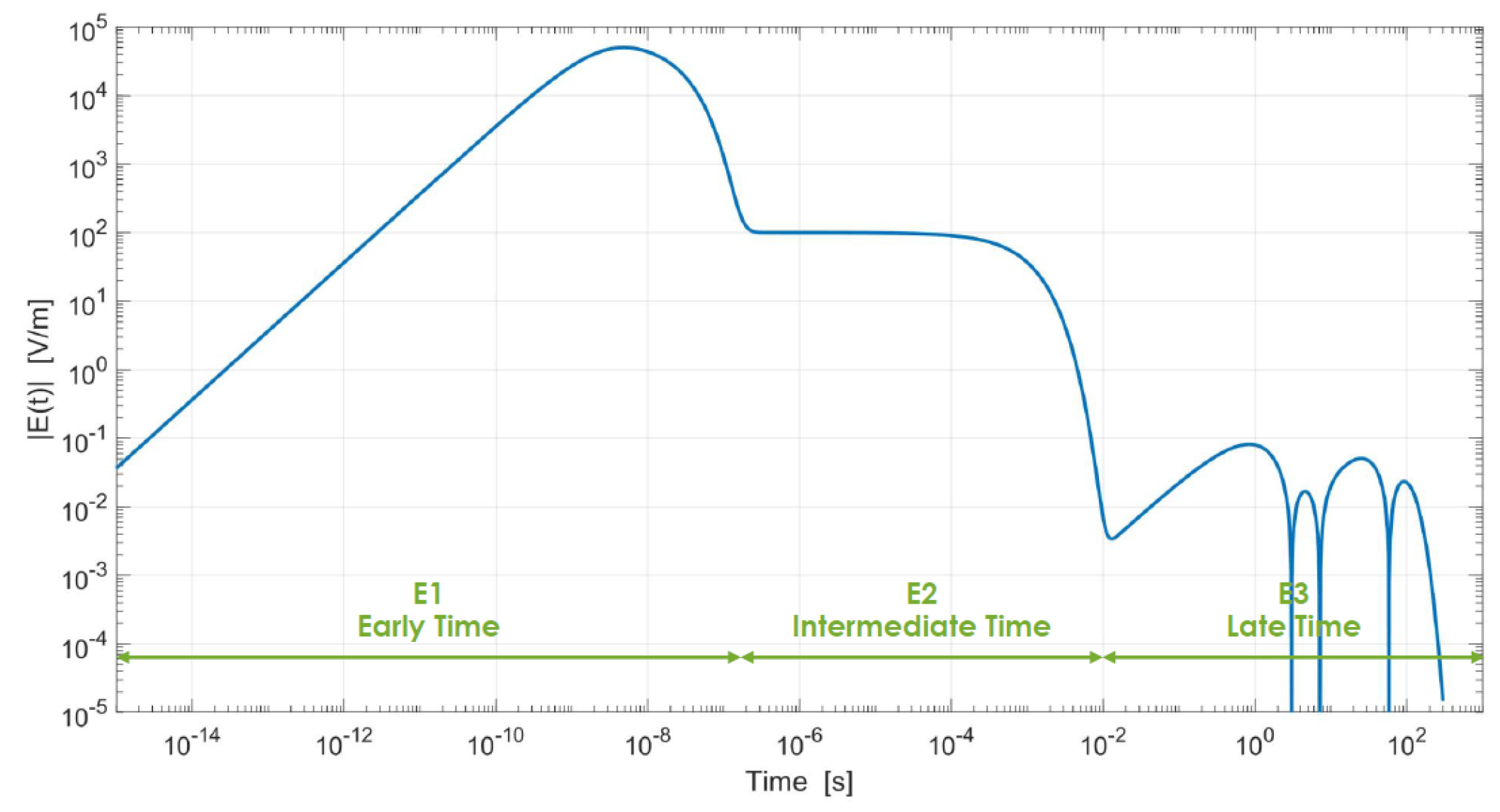
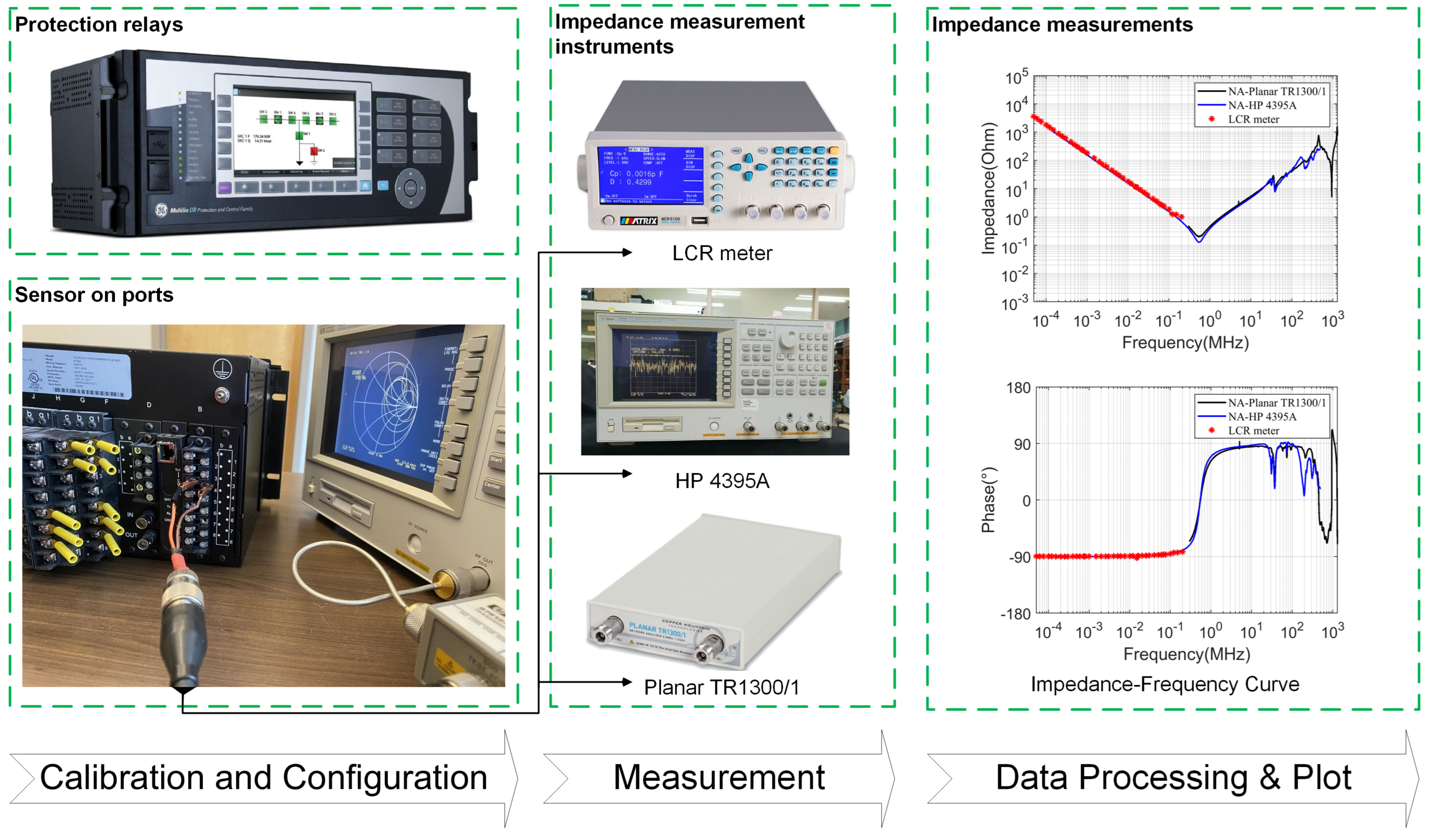

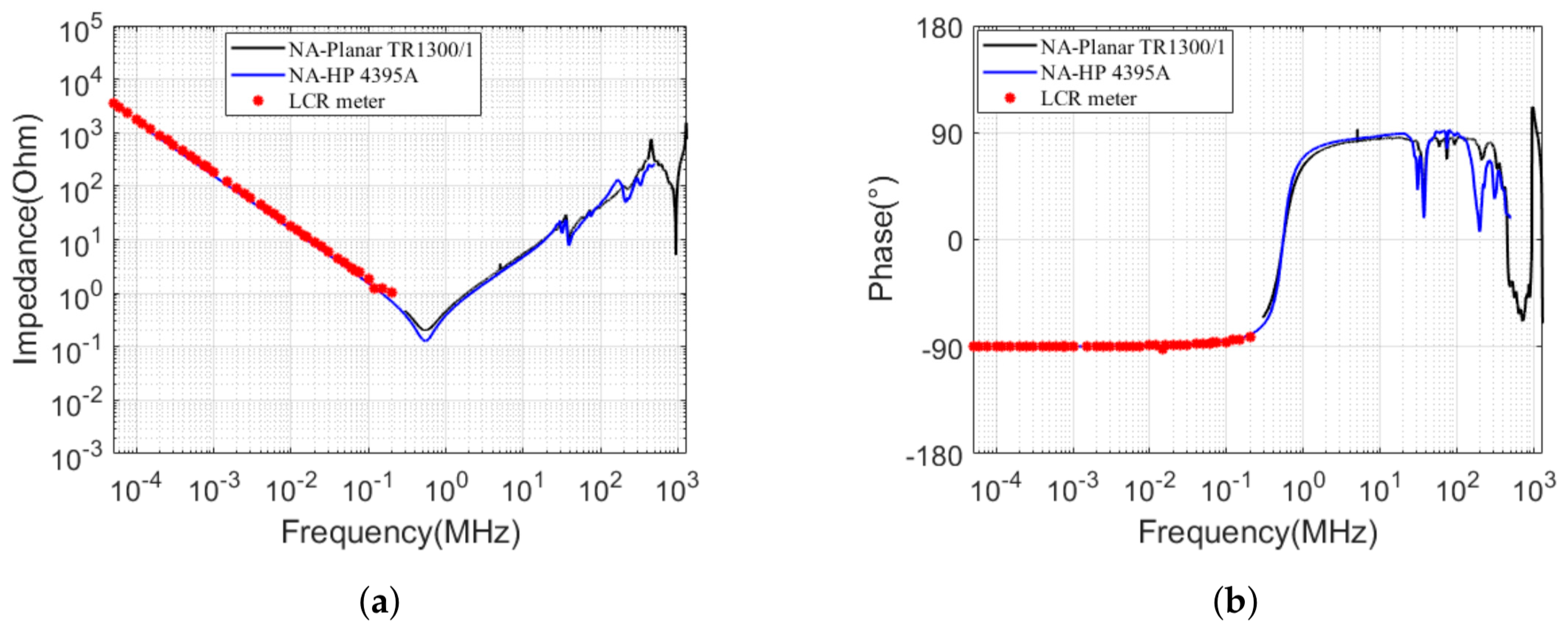



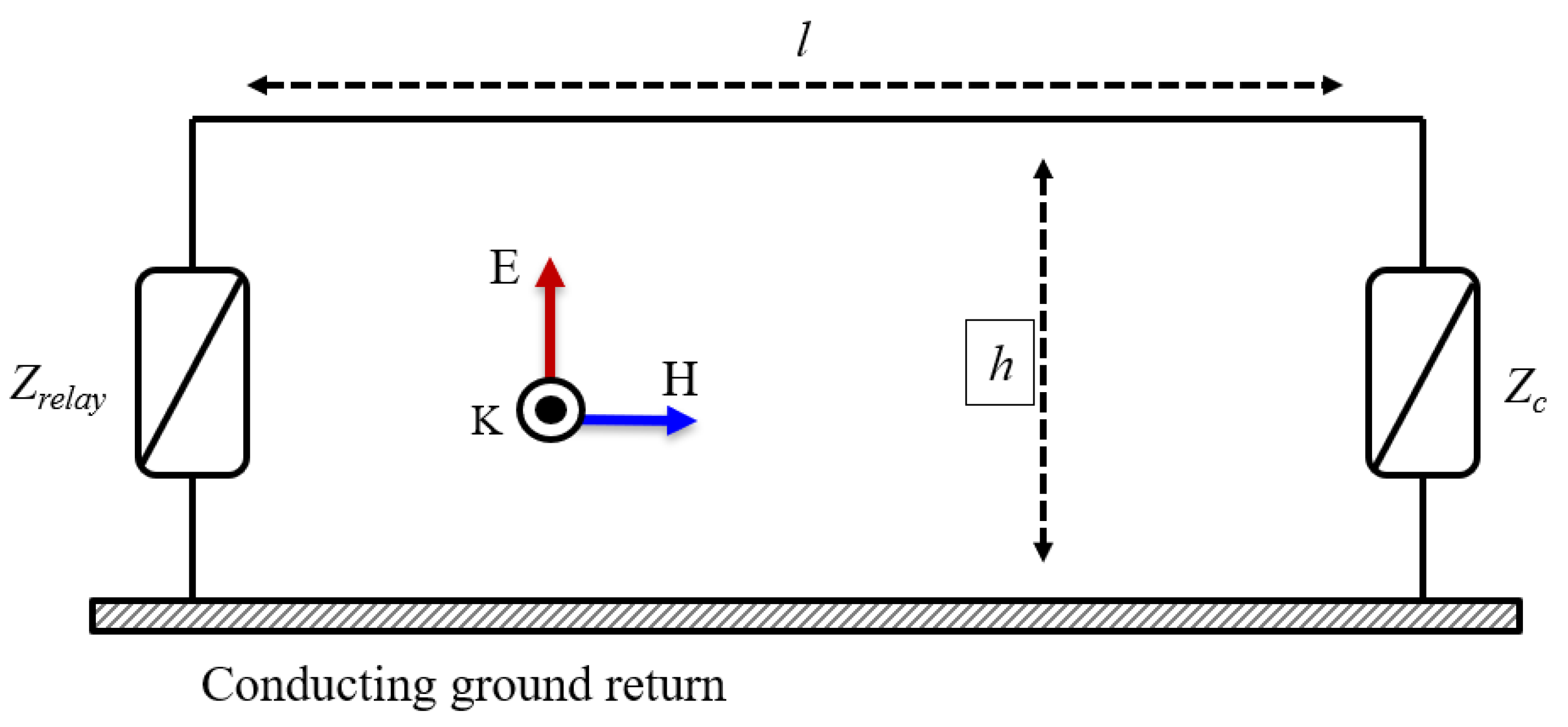

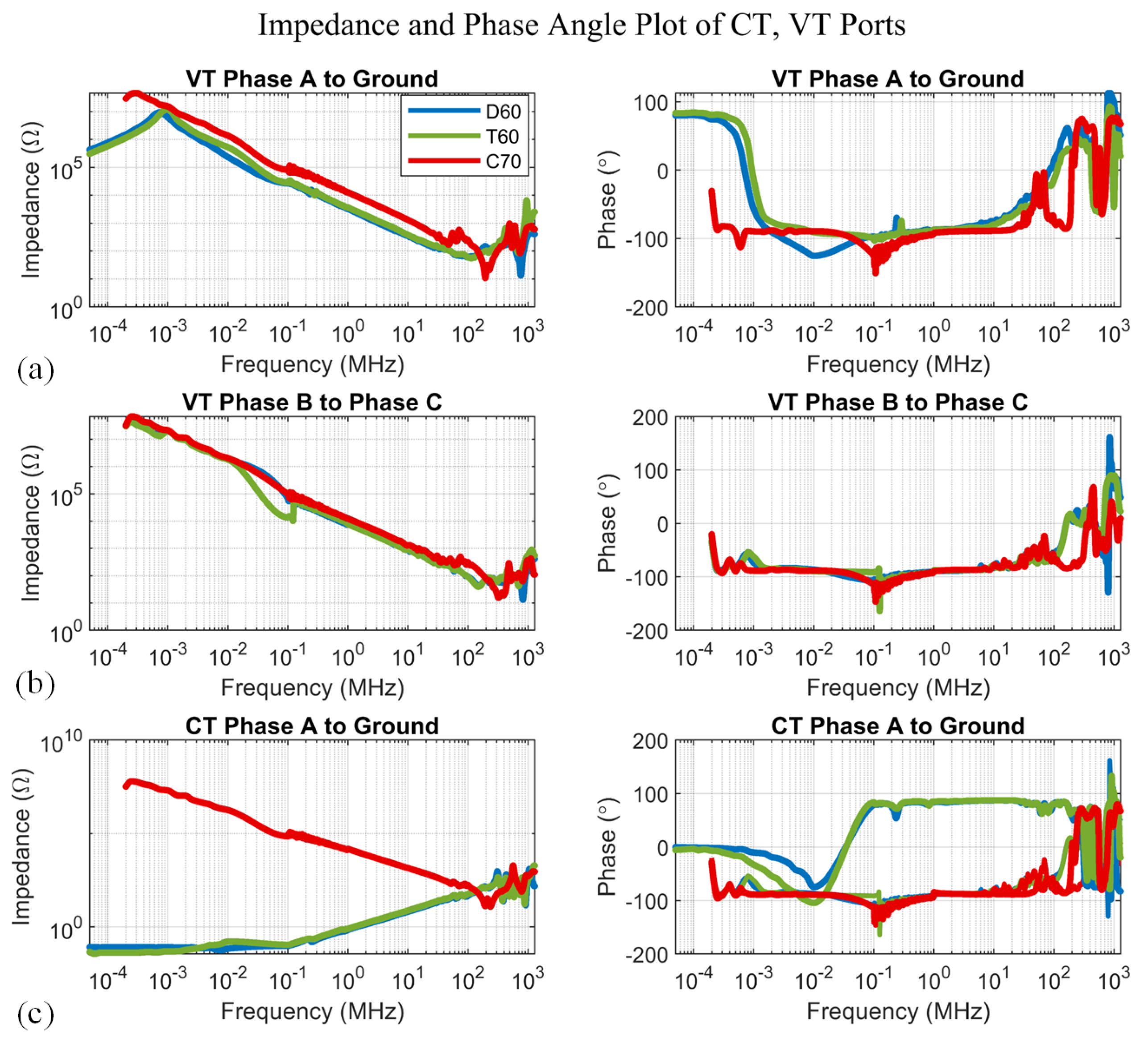
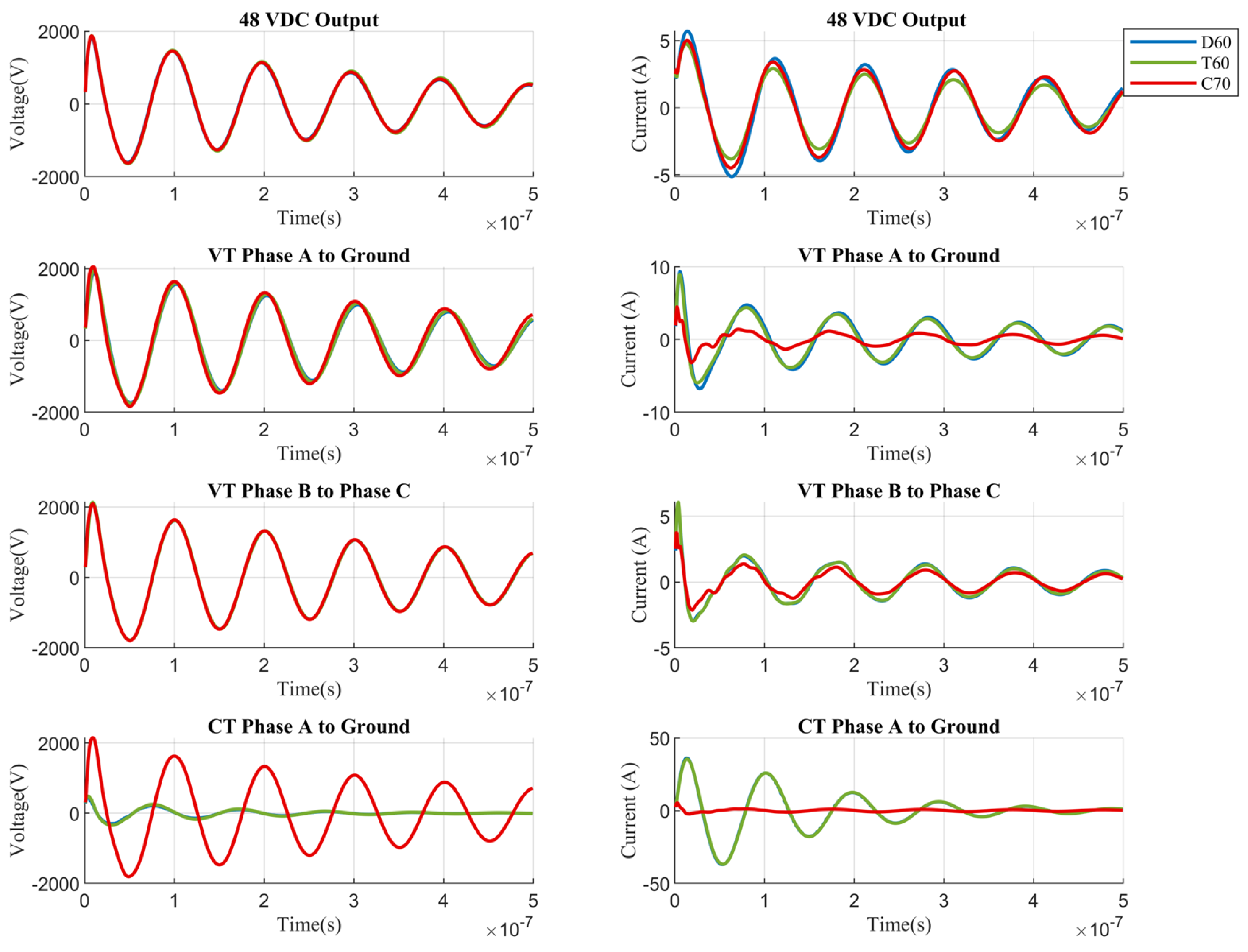

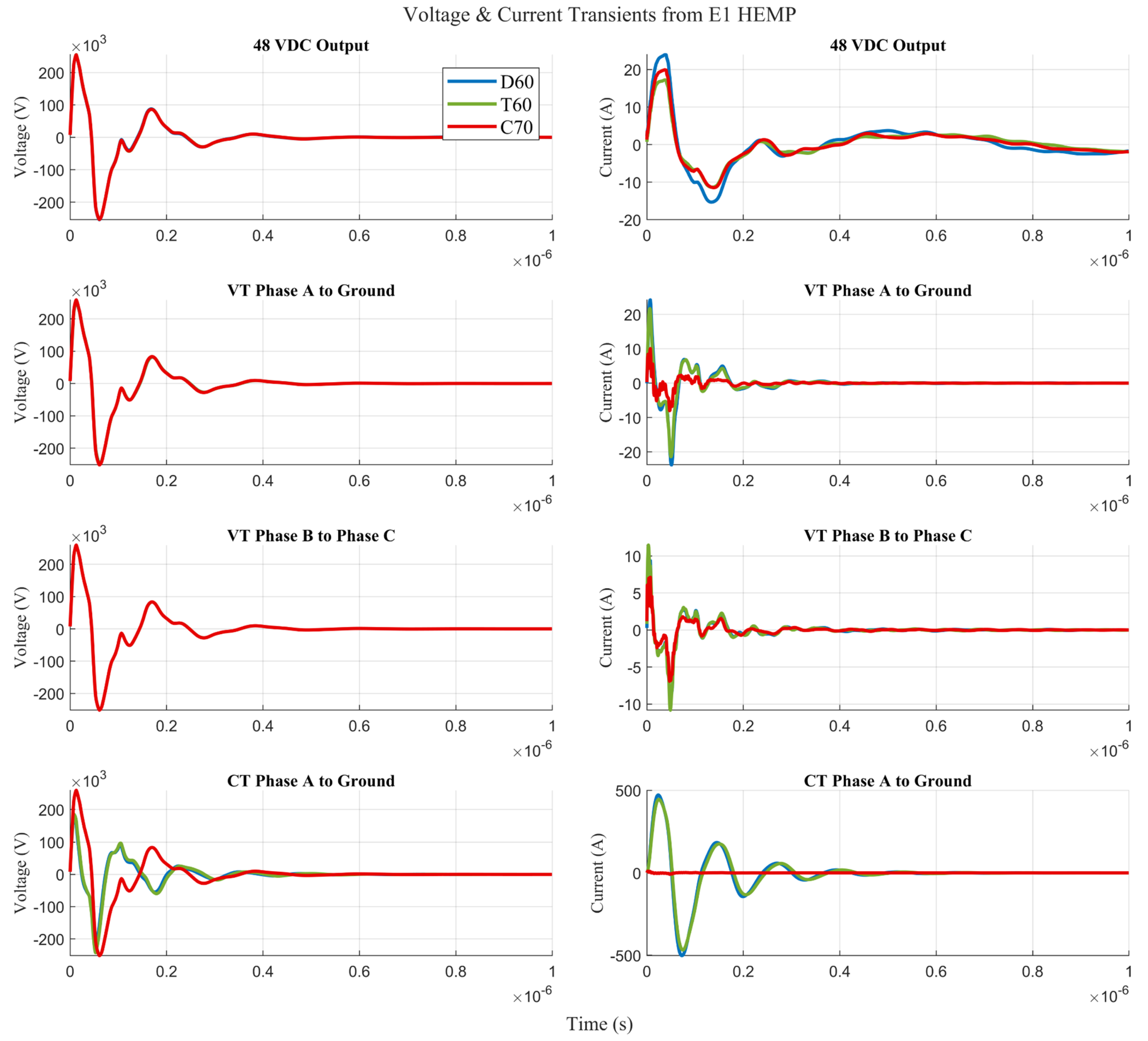
| LCR Meter | Imp. Analyzer | VNA | |
|---|---|---|---|
| Name | MCR-5200 | HP 4395A | Planar TR1300/1 |
| Adapter | - | HP 87512A | N1.1 Calibration Kit |
| Freq. range | 40 Hz–200 kHz | 10 Hz–500 MHz | 300 kHz–1.3 GHz |
| Imp. range | 0.1 mΩ–99.99 MΩ | <40 kΩ | - |
| Accuracy | >0.1% | 3–10% | 0.5–3% |
| Rise Time | Oscillation Frequency | Decaying | |
|---|---|---|---|
| Open-circuit voltage | 5 ns ± 30% | (3, 10, 30) MHz ± 10% | ; |
| Short-circuit current | 3 MHz: <330 ns; 10 MHz: <100 ns; 30 MHz: <33 ns | MHz ± 30% | ; |
| Load Resistance | Rise Time | Pulse Width | Peak Voltage |
|---|---|---|---|
| 50 Ω | ns | ns | 4 kV ± 10% |
| 1000 Ω | ns | 50 ns (−15 ns to +100 ns) | 7.6 kV ± 20% |
Disclaimer/Publisher’s Note: The statements, opinions and data contained in all publications are solely those of the individual author(s) and contributor(s) and not of MDPI and/or the editor(s). MDPI and/or the editor(s) disclaim responsibility for any injury to people or property resulting from any ideas, methods, instructions or products referred to in the content. |
© 2024 by the authors. Licensee MDPI, Basel, Switzerland. This article is an open access article distributed under the terms and conditions of the Creative Commons Attribution (CC BY) license (https://creativecommons.org/licenses/by/4.0/).
Share and Cite
Thotakura, N.L.; Wu, Y.; Mignardot, D.; Zhang, L.; Qiu, W.; Markel, L.C.; Liao, D.; McConnell, B.W.; Liu, Y. Impact Analysis of High-Altitude Electromagnetic Pulse Coupling Effects on Power Grid Protection Relays. Electronics 2024, 13, 1336. https://doi.org/10.3390/electronics13071336
Thotakura NL, Wu Y, Mignardot D, Zhang L, Qiu W, Markel LC, Liao D, McConnell BW, Liu Y. Impact Analysis of High-Altitude Electromagnetic Pulse Coupling Effects on Power Grid Protection Relays. Electronics. 2024; 13(7):1336. https://doi.org/10.3390/electronics13071336
Chicago/Turabian StyleThotakura, Naga Lakshmi, Yuru Wu, David Mignardot, Liang Zhang, Wei Qiu, Lawrence C. Markel, Dahan Liao, Benjamin W. McConnell, and Yilu Liu. 2024. "Impact Analysis of High-Altitude Electromagnetic Pulse Coupling Effects on Power Grid Protection Relays" Electronics 13, no. 7: 1336. https://doi.org/10.3390/electronics13071336
APA StyleThotakura, N. L., Wu, Y., Mignardot, D., Zhang, L., Qiu, W., Markel, L. C., Liao, D., McConnell, B. W., & Liu, Y. (2024). Impact Analysis of High-Altitude Electromagnetic Pulse Coupling Effects on Power Grid Protection Relays. Electronics, 13(7), 1336. https://doi.org/10.3390/electronics13071336








